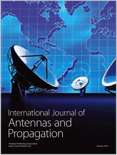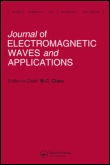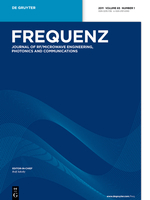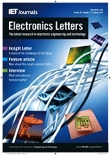
International Journal of Antennas and Propagation
Scope & Guideline
Advancing antenna technology for a connected world.
Introduction
Aims and Scopes
- Antennas Design and Optimization:
Research on innovative designs, optimization techniques, and performance enhancement of various antenna types, including MIMO, metamaterial, and wearable antennas. - Propagation Modeling and Analysis:
Studies that explore the characteristics of electromagnetic wave propagation in different environments, including urban, rural, and indoor scenarios. - Wireless Communication Technologies:
Investigations into antenna applications in modern wireless communication systems, including 5G, IoT, and mobile networks. - Scattering and Electromagnetic Interference:
Research on the scattering of electromagnetic waves by various objects and the implications for system performance and electromagnetic compatibility. - Advanced Signal Processing Techniques:
Development of algorithms and methodologies for signal processing in antenna systems, including beamforming, direction-of-arrival estimation, and channel modeling.
Trending and Emerging
- 5G and Beyond Technologies:
A significant increase in research focused on antennas for 5G and future wireless technologies, including MIMO systems and millimeter-wave applications. - Wearable and Flexible Antennas:
Growing interest in the design and implementation of wearable and flexible antennas, driven by the rise of health monitoring devices and IoT applications. - Metamaterials and Advanced Materials:
Research on the use of metamaterials and novel materials in antenna design is gaining traction, emphasizing their potential for miniaturization and enhanced performance. - Artificial Intelligence in Antenna Design:
Emerging methodologies incorporating AI and machine learning techniques for optimizing antenna designs and improving performance metrics. - Environmental Effects on Antenna Performance:
Increasing attention is being paid to how environmental factors impact antenna performance, particularly in urban and complex environments.
Declining or Waning
- Non-Antenna Related Applications:
There seems to be a reduction in papers focusing on non-antenna related applications, such as those related to educational technology or unrelated engineering disciplines. - Traditional Antenna Types:
The focus on traditional antenna types, such as basic dipole or monopole antennas, has diminished as the field moves towards more innovative and complex designs. - Low Frequency and VHF Applications:
Research targeting low-frequency and VHF antennas appears to be less prominent, likely due to the shift towards higher frequency applications, particularly in the context of 5G and beyond.
Similar Journals

Visnyk NTUU KPI Seriia-Radiotekhnika Radioaparatobuduvannia
Shaping Tomorrow's Technologies TodayVisnyk NTUU KPI Seriia-Radiotekhnika Radioaparatobuduvannia is a distinguished open-access journal published by the National Technical University of Ukraine, Kyiv Polytechnic Institute. Since its inception in 2009, the journal has been a vital platform for disseminating innovative research findings in the fields of radio engineering, electronic technology, and the development of radio apparatus. With its commitment to providing unrestricted access to high-quality scientific content, the journal aims to foster collaboration and knowledge exchange among researchers, practitioners, and educators both in Ukraine and globally. While the journal's H-index and Scopus rankings are currently not provided, its growing reputation in the academic community is indicative of its impact in advancing technology and engineering practices. The journal's accessibility ensures that cutting-edge research is available to a wide audience, making it a crucial resource for professionals and students seeking to stay informed about the latest advancements in radio technology and engineering.

Radiophysics and Quantum Electronics
Elevating Standards in Radiophysics ResearchRadiophysics and Quantum Electronics is a leading scholarly journal published by SPRINGER, dedicated to advancing knowledge in the fields of radiophysics and quantum electronics. With a rich publication history dating back to 1967 and covering anticipated insights up to 2024, the journal serves as a crucial resource for researchers engaged in the exploration of areas such as Astronomy and Astrophysics, Electrical and Electronic Engineering, and Nuclear and High Energy Physics. Although it is classified in lower quartiles in several categories, its ongoing commitment to quality research and critical advancements adds invaluable knowledge to the scientific community. The journal does not currently offer open access options, allowing for traditional publication standards that uphold rigor and academic integrity. Researchers, professionals, and students alike can benefit from the comprehensive articles and studies published within its pages, making Radiophysics and Quantum Electronics an essential addition to any academic library focused on the nuances of modern physics and engineering.

IEEE Microwave and Wireless Technology Letters
Unlocking the potential of microwave and wireless advancements.IEEE Microwave and Wireless Technology Letters is a pivotal journal dedicated to the rapid dissemination of original research and innovative developments in the realms of microwave and wireless technologies. Published by the esteemed IEEE-INST ELECTRICAL ELECTRONICS ENGINEERS INC, this journal facilitates open access to its content, ensuring that cutting-edge findings are readily available to a global audience. With a focus on high-impact research and practical applications, the journal covers a broad spectrum of topics including but not limited to microwave circuit design, wireless communication systems, and advanced materials for radio-frequency applications. As of 2023, the journal has achieved notable rankings within the Scopus database, boasting a rank of #105 in Condensed Matter Physics and #208 in Electrical and Electronic Engineering, placing it in the top quartiles of both fields. This combination of vibrant research and accessibility positions IEEE Microwave and Wireless Technology Letters as an essential resource for academics, industry professionals, and students striving to advance their knowledge in this rapidly evolving field.

JOURNAL OF ELECTROMAGNETIC WAVES AND APPLICATIONS
Unveiling the Potential of Electromagnetic WavesJournal of Electromagnetic Waves and Applications, published by Taylor & Francis Ltd, is a prestigious interdisciplinary journal that focuses on the rapidly evolving fields of electromagnetic waves and their applications. Since its inception in 1987, this journal has served as a vital resource for researchers, practitioners, and students interested in the latest advancements in electrical and electronic engineering, as well as materials science. The journal holds a respectable Q3 ranking in Electrical and Electronic Engineering and Electronic, Optical, and Magnetic Materials, and Q2 in Physics and Astronomy according to the 2023 category quartiles. With a dedicated readership, it aims to publish high-quality research articles that foster innovation and knowledge sharing among the scientific community. Despite not being open access, the journal ensures widespread availability of its insightful content aimed at pushing the boundaries of knowledge in the electromagnetic spectrum. As a crucial platform for disseminating cutting-edge research, the Journal of Electromagnetic Waves and Applications continues to contribute significantly to the advancement of technology and materials science.

FREQUENZ
Connecting Ideas in Electrical Engineering ResearchFREQUENZ is a prestigious academic journal published by Walter de Gruyter GmbH, focusing on the dynamic field of Electrical and Electronic Engineering. Established in 1949, this journal has a long-standing tradition of disseminating high-quality research and developments within the engineering community. With an ISSN of 0016-1136 and an E-ISSN of 2191-6349, it offers a well-rounded platform for both theoretical and practical advancements in electrical and electronic technologies. The journal is indexed in Scopus, holding a rank of #470 out of 797 in its category, placing it in the 41st percentile, which highlights its relevance and impact within the profession. Although not open access, FREQUENZ remains a vital resource for researchers, professionals, and students seeking to stay abreast of the latest innovations and scholarly discussions in the field. The journal's commitment to quality and its significant contribution to the advancement of knowledge represent invaluable assets in supporting the growth of the engineering community.

ELECTRONICS LETTERS
Advancing Knowledge in Electrical Engineering.ELECTRONICS LETTERS, published by WILEY, is a leading peer-reviewed journal dedicated to the field of Electrical and Electronic Engineering. With a rich history dating back to 1965, this journal serves as a prominent platform for disseminating novel research and innovations in electronics, covering topics such as circuit design, telecommunications, and signal processing. In 2021, the journal transitioned to an Open Access format, ensuring that cutting-edge research is freely accessible to a global audience, thereby enhancing its impact and outreach. The journal currently holds a Q3 quartile ranking in its category, reflecting its solid position among its peers, and ranks #451 out of 797 in Scopus for Electrical and Electronic Engineering, placing it within the 43rd percentile. ELECTRONICS LETTERS is essential for researchers, professionals, and students looking to stay abreast of the latest developments and contribute to advancements in the field, fostering collaboration and knowledge sharing in a rapidly evolving landscape.

Electrica
Empowering engineering minds with open access knowledge.Electrica is a prominent open access journal dedicated to advancing the field of Electrical and Electronic Engineering. Published by AVES since its inception in 2018, it has rapidly established itself as a crucial platform for disseminating high-quality research and innovative findings within the engineering community. With an ISSN of 2619-9831, Electrica operates under a rigorous peer-review process to maintain its scholarly integrity while promoting accessibility and knowledge sharing. Positioned in the third quartile of the 2023 rankings for Electrical and Electronic Engineering on Scopus, the journal has garnered a significant following, ranked #490 out of 797 in its category, reflecting its growing impact in the field. Researchers, professionals, and students can benefit from the wealth of resources available through this journal, as it not only provides a space for emerging ideas but also fosters collaboration and dialogue among experts. The journal's commitment to disseminating impactful research continues to shape the future of electrical engineering in Turkey and beyond.

Journal of Electrical Engineering & Technology
Illuminating the Path of Electrical Engineering ResearchJournal of Electrical Engineering & Technology is a prominent academic journal published by SPRINGER SINGAPORE PTE LTD, dedicated to advancing the field of Electrical and Electronic Engineering. With an established history since 2008, the journal has become a vital resource for professionals, researchers, and students seeking to explore innovative research and technological developments within the discipline. The journal boasts a commendable 2023 Scopus Rank of #334 out of 797 in its category, reflecting its quality and the impact of published works. As a Q2 category journal, it upholds rigorous peer-review standards, making it a credible platform for disseminating groundbreaking findings. While currently not an open-access publication, the journal ensures that its content is accessible to a global audience committed to knowledge enhancement and technological progress. Subscribe or access issues through institutional affiliations to stay at the forefront of advancements in electrical engineering.

MICROWAVE JOURNAL
Elevating Standards in Microwave ResearchMicrowave Journal, published by Horizon House Publications Inc, is a well-established platform in the field of Electrical and Electronic Engineering, specifically focusing on the advancements and applications of microwave technology. Since its inception in 1969, the journal has consistently delivered high-quality research, making it an invaluable resource for professionals, researchers, and students alike. Despite its Q4 ranking in Scopus for 2023, the journal plays a crucial role in disseminating knowledge and fostering innovation within its niche, showcasing developments across various areas including microwave systems, components, and applications. Although it does not offer Open Access, the journal’s comprehensive insights and peer-reviewed articles are essential for anyone looking to deepen their understanding of microwave engineering. By maintaining a rigorous editorial standard, Microwave Journal continues to shape the discussion and evolution of microwave technology.

Progress in Electromagnetics Research Letters
Fostering Excellence in Electromagnetic ResearchProgress in Electromagnetics Research Letters, published by EMW PUBLISHING, is a vital peer-reviewed journal dedicated to the fields of electronics, optics, and magnetics. With an emphasis on innovative research and technological advancements, this journal has established itself in the academic community since its inception in 2008, and it will continue to publish valuable findings through 2024. The journal holds a respectable Q3 ranking in Electronic, Optical and Magnetic Materials, positioning it among the noteworthy contributions to the field, despite its percentile standing in Scopus. Researchers and professionals benefit from its commitment to disseminating high-quality research without the constraints of open access, ensuring that cutting-edge ideas reach a targeted audience. By fostering knowledge exchange, Progress in Electromagnetics Research Letters is poised to influence current and future advancements in electromagnetic technologies, making it a trusted platform for scholars and practitioners alike.